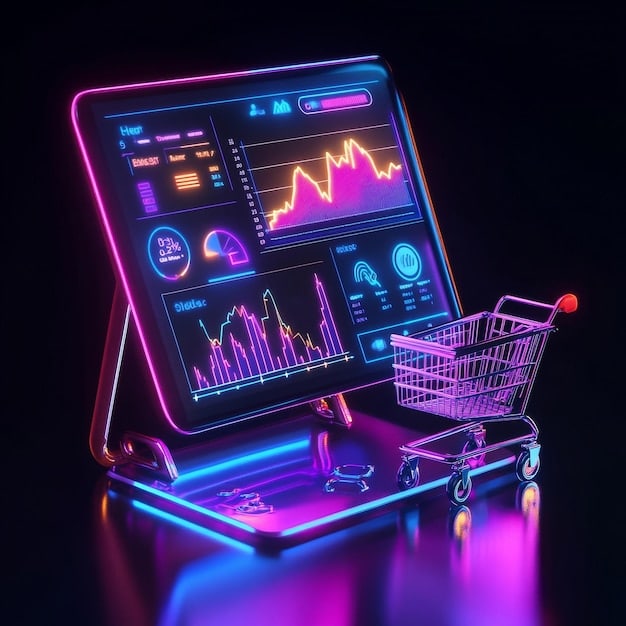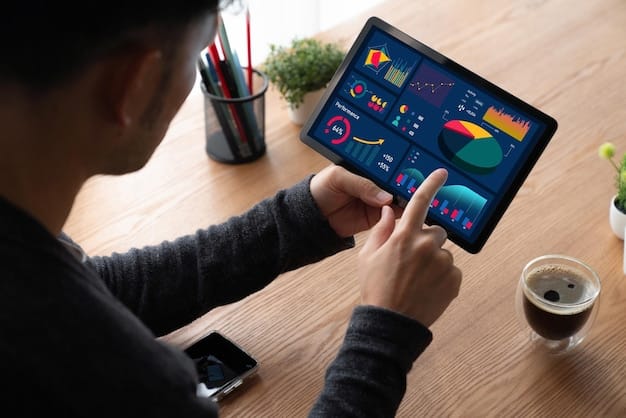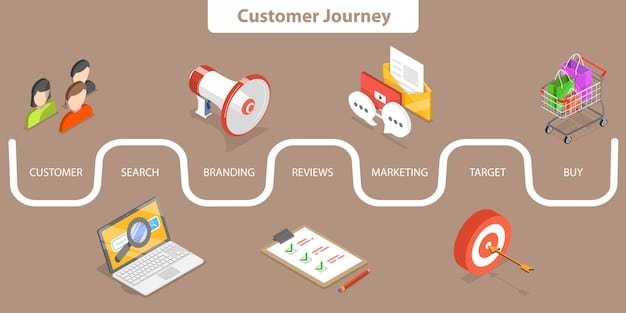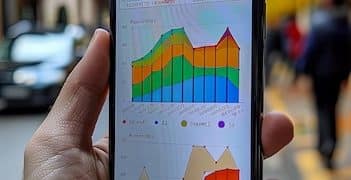Boost E-commerce Conversions 15% with 2025 Google Ads

Achieving a 15% increase in e-commerce conversion rates through updated Google Ads strategies in 2025 requires a multi-faceted approach, focusing on refined targeting, AI-driven automation, enhanced creative optimization, and a deep understanding of evolving consumer behavior to maximize return on ad spend.
In the dynamic world of online retail, staying ahead means constantly evolving your strategies. For e-commerce businesses aiming to significantly boost their performance, the goal isn’t just about driving traffic, but converting that traffic into sales. This article explores how to achieve a remarkable 15% increase in e-commerce conversion rates by using updated Google Ads strategies in 2025, leveraging the latest advancements in digital marketing.
Optimizing Campaign Structure for Performance Max and AI
The landscape of Google Ads is continuously shifting, with a strong emphasis on automation and AI-driven solutions. In 2025, maximizing your e-commerce conversion rates hinges on effectively integrating these advancements, particularly through campaigns like Performance Max. Transitioning from traditional campaign structures means embracing a more holistic, goal-oriented approach.
Performance Max represents a significant evolution, allowing advertisers to access all of Google’s inventory from a single campaign. However, its effectiveness is not automatic; careful setup and continuous optimization are crucial. Businesses must feed the system with high-quality signals and assets to guide the AI effectively. This includes providing comprehensive audience signals, high-quality product feeds, and diverse creative assets that resonate across various Google properties.
Leveraging first-party data for enhanced targeting
As privacy regulations tighten and third-party cookies diminish, first-party data becomes an invaluable asset for Google Ads. Utilizing your customer data, such as purchase history, website behavior, and CRM information, allows for unparalleled segmentation and personalized ad experiences. This data can be uploaded to Google Ads as customer match lists, feeding the AI with precise audience signals.
- Customer Match Lists: Segment your customer base by loyalty, recency of purchase, or purchase value to create highly targeted ad groups.
- Website Visitor Data: Implement robust tracking (Google Analytics 4) to capture detailed user journeys and preferences for remarketing.
- CRM Integration: Connect your CRM system to Google Ads to automatically update customer segments and improve targeting accuracy.
- Surveys and Feedback: Gather qualitative data directly from customers to inform your advertising copy and creative choices.
By providing Google’s AI with rich first-party data, you empower it to find more users who resemble your most valuable customers, leading to significantly higher conversion probabilities. This strategic use of proprietary data is a cornerstone of boosting e-commerce conversion rates in 2025.
The continuous refinement of audience signals and asset groups within Performance Max is an ongoing process. Advertisers should regularly review performance metrics, test different ad creatives, and update product feeds to ensure the AI has the most relevant information to optimize for conversions. This proactive management is what differentiates successful campaigns from those that merely exist.
Creative Optimization and Dynamic Asset Blending
In 2025, static ads are increasingly losing their luster. Consumers are bombarded with content, and only highly relevant, visually engaging, and dynamic ads cut through the noise. Google Ads, especially through Performance Max, thrives on a diverse array of creative assets that can be dynamically blended and served across multiple formats and platforms.
This means investing in high-quality images, compelling video content, engaging headlines, and persuasive descriptions. The AI takes these assets and automatically generates various ad formats tailored to specific placements (YouTube, Display, Search, Discover, Gmail), optimizing for the best performance. The key is to provide enough variety for the system to experiment and learn what resonates most with different audience segments.
Crafting compelling ad copy and visuals
Ad copy must be concise, benefit-oriented, and include a clear call to action. It should speak directly to the customer’s pain points or desires, offering a solution that your product provides. Visuals, whether images or videos, need to be high-resolution, professional, and consistent with your brand identity. Video content, in particular, is proving increasingly effective in capturing attention and conveying product value quickly.
- A/B Test Headlines: Experiment with different hooks and value propositions in your ad headlines to see which ones drive the most engagement.
- High-Quality Images: Use professional product photography that showcases features and benefits clearly. Consider lifestyle images that depict the product in use.
- Short, Engaging Videos: Create 15-30 second videos highlighting product benefits, customer testimonials, or how-to guides.
- Vary Ad Descriptions: Write multiple ad descriptions, focusing on different aspects of your product or service to cater to diverse motivations.

By focusing on strong creatives and dynamic asset blending, e-commerce businesses can significantly improve their ad’s relevance and appeal, directly contributing to higher click-through rates and, ultimately, increased conversion rates. The AI’s ability to match the best creative combination to the right user at the right moment is a powerful tool for conversion optimization.
Enhanced Bidding Strategies and Budget Allocation
Smart Bidding in Google Ads has come a long way, and in 2025, it’s more sophisticated than ever. Relying on advanced machine learning, these strategies optimize bids in real-time to maximize conversions or conversion value, taking into account a vast array of contextual signals. For e-commerce, strategies like “Target CPA” (Cost Per Acquisition) and “Maximize Conversion Value” are particularly potent.
However, simply selecting a smart bidding strategy isn’t enough. Advertisers must feed the system with accurate conversion data and set realistic targets. If your conversion tracking is flawed or your target CPA is too aggressive, the AI will struggle to deliver optimal results. Regularly audit your conversion actions and ensure they accurately reflect valuable customer interactions.
Budget allocation also plays a critical role. Instead of spreading your budget thinly across numerous underperforming campaigns, focus resources on those that demonstrate the highest return on ad spend (ROAS). Performance Max campaigns, by design, aim to do this automatically, but understanding its internal logic and guiding it through proper asset and signal provisioning is essential. Consider a dynamic budget allocation where spending shifts towards channels or campaigns that are currently performing best.
Micro-optimizations for macro results
Beyond the high-level bidding strategies, a series of micro-optimizations can collectively lead to that 15% conversion rate increase. This includes negative keyword lists, geographical bid adjustments, device bid adjustments, and time-of-day scheduling. While Performance Max automates many of these, for Search campaigns, these manual refinements remain crucial.
- Granular Negative Keywords: Continuously update your negative keyword lists to filter out irrelevant searches and wasted spend.
- Geographic Targeting Refinement: Analyze conversion data by location and adjust bids to prioritize high-performing regions.
- Device Bid Adjustments: Identify which devices (mobile, desktop, tablet) drive the most conversions and adjust bids accordingly.
- Ad Scheduling: Schedule your ads to run during hours and days when your target audience is most active and likely to convert.
These smaller adjustments, when combined with robust bidding strategies, allow for a much more efficient use of ad budget, directly influencing profitability and conversion rates. The goal is to spend every dollar as effectively as possible, ensuring it reaches the right person at the right time with the right message.
Personalization and User Experience on Landing Pages
Driving traffic to your site is only half the battle; converting that traffic requires an exceptional user experience (UX) on your landing pages. In 2025, personalization is no longer a luxury but a necessity. Your landing pages need to seamlessly continue the narrative established by your Google Ads, offering a tailored experience that aligns with the user’s initial search intent or ad exposure.
This means dynamic content that changes based on geographical location, user behavior, or even the specific ad clicked. For instance, if an ad promises a discount on “women’s running shoes,” the landing page should immediately display relevant products with the promised discount clearly visible, without requiring further navigation.
Furthermore, the entire conversion funnel, from ad click to checkout, must be frictionless. Page load speed, mobile responsiveness, clear calls to action, and intuitive navigation are non-negotiable. Any friction point can lead to cart abandonment and lost conversions. Businesses should regularly audit their site for performance and user experience issues.
Optimizing the post-click experience
The post-click experience is where the conversion magic happens. It’s not just about aesthetics but about guiding the user effortlessly towards their goal. This involves clear product information, compelling social proof, and a streamlined checkout process.
- Match Ad to Landing Page: Ensure a consistent message and visual experience from ad creative to landing page content.
- Fast Load Times: Optimize images and code to ensure landing pages load instantly, especially on mobile devices.
- Clear Calls to Action: Use prominent and persuasive CTAs that tell users exactly what to do next.
- Social Proof Integration: Display customer reviews, ratings, and testimonials prominently to build trust.
- Streamlined Checkout: Reduce the number of steps in the checkout process and offer guest checkout options.
By creating highly personalized and optimized landing page experiences, e-commerce stores can significantly reduce bounce rates and improve their conversion funnels. The goal is to make the purchasing journey as easy and enjoyable as possible for every potential customer.
Integrating CRM and Attribution Modeling
To truly understand and optimize your Google Ads performance for increased conversion rates, a robust integration with your Customer Relationship Management (CRM) system and a sophisticated attribution model are essential in 2025. CRM data provides invaluable insights into customer lifetime value (LTV), which Google Ads can use to optimize bids for higher-value conversions, rather than just any conversion.
By connecting your CRM, you can pass offline conversion data back to Google Ads, allowing the AI to learn which types of clicks lead to your most profitable customers, even if the final sale happens offline or much later. This creates a much more accurate picture of your return on investment. Furthermore, you can use CRM data to build precise audience segments for remarketing and exclusion lists, ensuring your ads are always targeting the most relevant prospects.

Attribution modeling has also evolved. While last-click attribution was once the default, more advanced models like data-driven attribution (DDA) are now standard. DDA uses machine learning to assign credit to each touchpoint throughout the customer journey, providing a more granular understanding of how various Google Ads campaigns contribute to conversions. This allows for more informed budget allocation and optimization decisions, ensuring you’re not undervaluing crucial early-stage interactions.
Beyond basic conversion tracking
Moving beyond basic conversion tracking to a holistic view of the customer journey is vital. This includes:
- Offline Conversion Import: Upload sales data from your CRM to Google Ads to attribute offline purchases to specific ad interactions.
- Enhanced Conversion Tracking: Use Google Tag Manager to implement advanced conversion tracking, capturing more granular data about user actions.
- Cross-Device Tracking: Understand how users interact with your ads across different devices before converting, informing a more fluid user experience.
- Data-Driven Attribution: Actively use Google’s data-driven attribution model to allocate credit across all touchpoints, optimizing for a full-funnel strategy.
By integrating CRM data and leveraging advanced attribution models, e-commerce businesses gain a comprehensive understanding of their customers and the true impact of their Google Ads investments. This data-rich environment enables highly precise optimizations that directly contribute to increasing conversion rates by 15% or more.
Compliance and Trust in a Privacy-Centric World
As we navigate 2025, consumer trust and data privacy are paramount. E-commerce businesses using Google Ads must adhere strictly to evolving privacy regulations (like GDPR, CCPA, and similar state laws in the US) and Google’s own policies. Non-compliance not only risks legal penalties but also erodes customer trust, which can severely impact conversion rates.
Transparency is key. Ensure your website has a clear, easily accessible privacy policy that outlines how user data is collected, used, and protected. Implement accurate and compliant consent management platforms (CMPs) to manage user preferences for cookies and data tracking. This builds confidence with your audience, making them more likely to interact with your ads and, ultimately, convert.
Google is also heavily investing in privacy-preserving technologies and tools, such as “consent mode,” which adjusts how Google tags behave based on users’ consent status. Adopting and correctly implementing these tools is crucial for maintaining data accuracy while respecting user privacy, allowing for effective ad personalization within legal and ethical boundaries.
Building consumer confidence through best practices
Proactive measures in privacy and transparency can transform potential liabilities into competitive advantages. Consumers are more likely to engage with brands they trust.
- Transparent Privacy Policy: Clearly communicate data usage practices on your website.
- Cookie Consent Management: Implement compliant consent banners and allow users granular control over their data.
- Secure Data Handling: Ensure all customer data is protected with robust security measures.
- Ad Personalization Disclosures: Be clear about how ad personalization works and offer opt-out options where applicable.
By prioritizing compliance and fostering a transparent relationship with customers regarding data use, e-commerce businesses can not only avoid pitfalls but also strengthen their brand reputation, leading to a more engaged and trusting audience base. This trust directly translates into higher conversion rates, as consumers feel secure in making purchases.
| Key Strategy | Brief Description |
|---|---|
| 🚀 Performance Max & AI | Utilize Google’s AI-driven campaigns with rich first-party data for broad reach and optimized conversions. |
| 🎨 Dynamic Creative Optimization | Provide varied, high-quality ad assets for AI to blend and test across platforms. |
| 📊 Smart Bidding & Budgeting | Apply advanced bidding strategies and allocate budgets to high-performing campaigns and segments. |
| 🔒 Privacy & Compliance | Maintain strict adherence to privacy regulations and build trust through transparent data practices. |
Frequently Asked Questions About E-commerce Conversions
The most critical change is the increased reliance on AI-driven campaigns, particularly Performance Max. Advertisers must shift from manual micro-management to strategic asset and signal provisioning, feeding Google’s AI with high-quality first-party data and diverse creative assets to optimize for conversion value across all its inventory.
First-party data allows for highly precise audience segmentation and personalization. By uploading customer match lists and leveraging website visitor data, businesses can teach Google’s AI to target users who are most likely to convert, significantly increasing ad relevance and the probability of a sale while reducing wasted ad spend.
Creative assets are paramount. Google’s AI dynamically generates ad variations across various platforms. Providing a wide range of high-quality images, videos, headlines, and descriptions enables the AI to test and serve the most effective combinations, ensuring ads are always engaging and relevant, leading to higher click-through and conversion rates.
A seamless post-click user experience directly impacts conversion rates. If a landing page doesn’t align with the ad or is slow, confusing, or not mobile-friendly, users will abandon it. Optimizing page speed, mobile responsiveness, offering clear calls to action, and streamlining the checkout process reduce friction and encourage purchases.
Privacy compliance builds trust with consumers. Transparent data practices and adherence to regulations like GDPR or CCPA reassure users, making them more comfortable interacting with your ads and sharing their information for purchases. This foundation of trust is crucial for maintaining and increasing conversion rates in a privacy-centric digital environment.
Conclusion
Achieving a 15% increase in e-commerce conversion rates by 2025 through Google Ads is an ambitious yet attainable goal for businesses willing to embrace the evolving digital marketing landscape. This requires a strategic shift towards leveraging AI-driven campaign structures like Performance Max, enriching these systems with high-quality first-party data, and investing in diverse and dynamic creative assets. Beyond the ad platform itself, optimizing the post-click user experience with personalization and ensuring strict compliance with privacy regulations are equally critical. By meticulously focusing on these updated strategies, e-commerce businesses can not only drive more traffic but also convert a significantly larger portion of it into loyal customers, securing their place in a competitive market.





